关于历史的常用词汇
- 格式:docx
- 大小:25.11 KB
- 文档页数:9
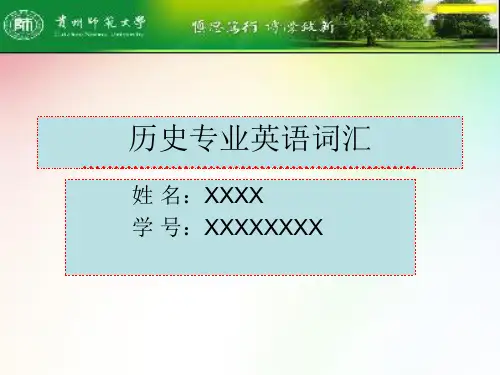
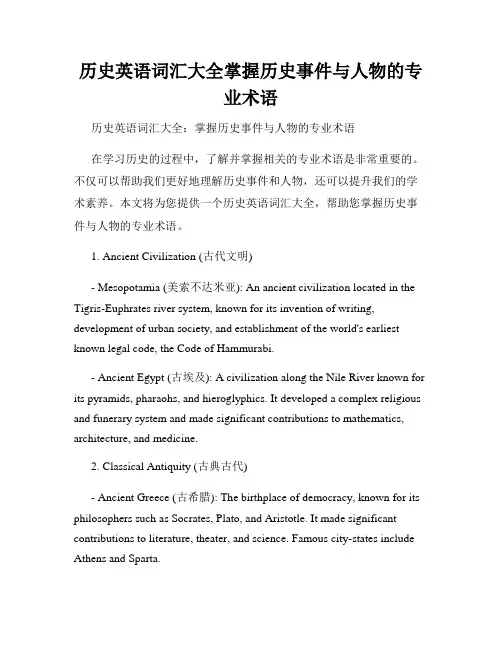
历史英语词汇大全掌握历史事件与人物的专业术语历史英语词汇大全:掌握历史事件与人物的专业术语在学习历史的过程中,了解并掌握相关的专业术语是非常重要的。
不仅可以帮助我们更好地理解历史事件和人物,还可以提升我们的学术素养。
本文将为您提供一个历史英语词汇大全,帮助您掌握历史事件与人物的专业术语。
1. Ancient Civilization (古代文明)- Mesopotamia (美索不达米亚): An ancient civilization located in the Tigris-Euphrates river system, known for its invention of writing, development of urban society, and establishment of the world's earliest known legal code, the Code of Hammurabi.- Ancient Egypt (古埃及): A civilization along the Nile River known for its pyramids, pharaohs, and hieroglyphics. It developed a complex religious and funerary system and made significant contributions to mathematics, architecture, and medicine.2. Classical Antiquity (古典古代)- Ancient Greece (古希腊): The birthplace of democracy, known for its philosophers such as Socrates, Plato, and Aristotle. It made significant contributions to literature, theater, and science. Famous city-states include Athens and Sparta.- Ancient Rome (古罗马): A civilization that expanded from a small village to a vast empire, known for its legal system, engineering marvels like the Colosseum and aqueducts, and influence on European culture.3. Middle Ages (中世纪)- Feudalism (封建制度): A social and economic system based on the exchange of land for military service and loyalty. It characterized much of Europe during the Middle Ages.- Crusades (十字军东征): Series of military expeditions by Christians from Western Europe to reclaim the Holy Land from Muslim control. They lasted from the 11th to the 13th century.4. Renaissance (文艺复兴)- Humanism (人文主义): An intellectual movement that emphasized the study of classical texts, the importance of human potential, and the pursuit of knowledge, art, and science.- Leonardo da Vinci (列奥纳多·达·芬奇): An Italian polymath known for his contributions in the fields of art, science, mathematics, and engineering. Best known for his paintings Mona Lisa and The Last Supper.5. Age of Exploration (探险时代)- Christopher Columbus (克里斯托弗·哥伦布): An Italian explorer who completed four voyages across the Atlantic Ocean, opening the way for widespread European exploration and the eventual colonization of the Americas.- Ferdinand Magellan (费尔南多·麦哲伦): A Portuguese explorer who led the first circumnavigation of the globe. His expedition proved that the Earth was round.6. Industrial Revolution (工业革命)- Steam engine (蒸汽机): Invented by James Watt, the steam engine was a key invention that revolutionized transportation, manufacturing, and agriculture during the Industrial Revolution.- Factory system (工厂体系): A method of manufacturing that brought workers and machinery together in one place, leading to increased efficiency and mass production.7. World Wars (世界大战)- Treaty of Versailles (凡尔赛条约): The peace treaty signed in 1919, officially marking the end of World War I. It placed full blame on Germany and imposed heavy reparations, leading to future political and economic tensions.- D-Day (诺曼底登陆): The Allied invasion of Normandy, France on June 6, 1944, during World War II. It marked a major turning point in the war and led to the eventual defeat of Nazi Germany.通过了解并熟练掌握这些历史英语词汇,我们可以更深入地了解历史的各个时期和相关的事件与人物。
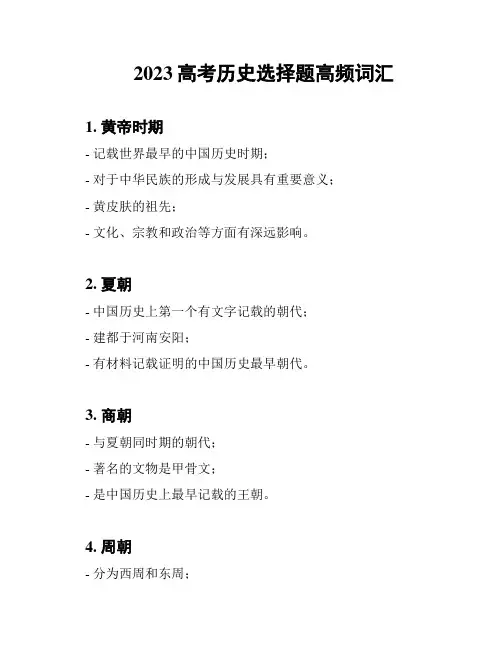
2023高考历史选择题高频词汇1. 黄帝时期- 记载世界最早的中国历史时期;- 对于中华民族的形成与发展具有重要意义;- 黄皮肤的祖先;- 文化、宗教和政治等方面有深远影响。
2. 夏朝- 中国历史上第一个有文字记载的朝代;- 建都于河南安阳;- 有材料记载证明的中国历史最早朝代。
3. 商朝- 与夏朝同时期的朝代;- 著名的文物是甲骨文;- 是中国历史上最早记载的王朝。
4. 周朝- 分为西周和东周;- 周天子实行天命思想;- 周天子分封诸侯,实行封建制度;- 社会政治发展的时期,也是诸侯国频繁征战的时期。
5. 春秋战国时期- 春秋和战国是中国历史上的连续时期;- 是中国古代文化思想发展的重要时期;- 诸侯之间频繁争斗,各国力量大致平衡。
6. 秦朝- 中国历史上第一个统一的封建中央集权王朝;- 秦始皇统一六国,建立起中央集权制度;- 著名的事迹是焚书坑儒、修建万里长城。
7. 汉朝- 是中国历史上继使秦统一后的封建王朝;- 在农业、手工业、商业、科技和文化等方面取得了较大发展;- 兴办学校,推行儒学教育。
8. 三国时期- 中国历史上的一个特殊历史时期;- 三个势力的争霸,三个割据分裂;- 曹操、刘备、孙权是这个时期的代表。
9. 隋朝- 是中国历史上继续魏晋南北朝之后的封建王朝;- 它的统一结束了南北朝分裂的局面;- 高度重视维护社会稳定。
10. 唐朝- 是中国历史上最灿烂的封建王朝;- 实行科举制度,为国家选拔人才;- 丝绸之路通商发展,辉煌的地理位置。
11. 宋朝- 是中国历史上的一个朝代;- 北宋和南宋两个时期;- 科技、艺术和文化方面取得很大的发展。
12. 元朝- 是中国历史上由蒙古族所建立的封建王朝;- 北京成为都城;- 世界上最大的封建王朝。
13. 明朝- 是中国历史上继元朝之后的一个封建王朝;- 地地道道的中国人自己政权;- 世界文明史上有重要地位。
14. 清朝- 是中国历史上朝代最后一政权;- 是清朝统治者的一个民族称谓。
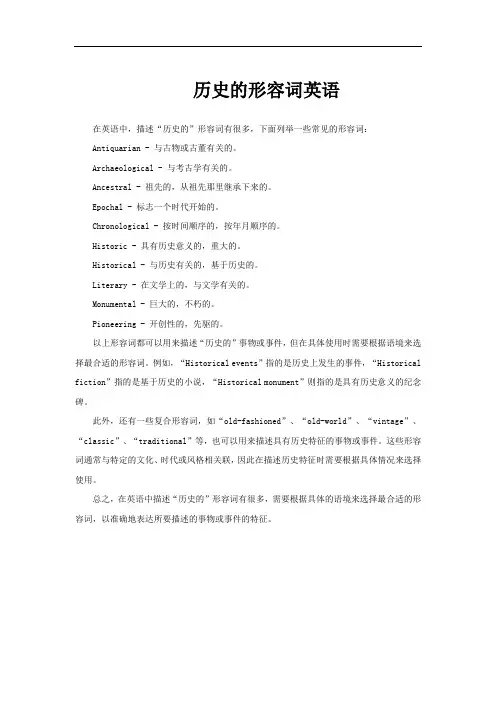
历史的形容词英语
在英语中,描述“历史的”形容词有很多,下面列举一些常见的形容词:
Antiquarian - 与古物或古董有关的。
Archaeological - 与考古学有关的。
Ancestral - 祖先的,从祖先那里继承下来的。
Epochal - 标志一个时代开始的。
Chronological - 按时间顺序的,按年月顺序的。
Historic - 具有历史意义的,重大的。
Historical - 与历史有关的,基于历史的。
Literary - 在文学上的,与文学有关的。
Monumental - 巨大的,不朽的。
Pioneering - 开创性的,先驱的。
以上形容词都可以用来描述“历史的”事物或事件,但在具体使用时需要根据语境来选择最合适的形容词。
例如,“Historical events”指的是历史上发生的事件,“Historical fiction”指的是基于历史的小说,“Historical monument”则指的是具有历史意义的纪念碑。
此外,还有一些复合形容词,如“old-fashioned”、“old-world”、“vintage”、“classic”、“traditional”等,也可以用来描述具有历史特征的事物或事件。
这些形容词通常与特定的文化、时代或风格相关联,因此在描述历史特征时需要根据具体情况来选择使用。
总之,在英语中描述“历史的”形容词有很多,需要根据具体的语境来选择最合适的形容词,以准确地表达所要描述的事物或事件的特征。
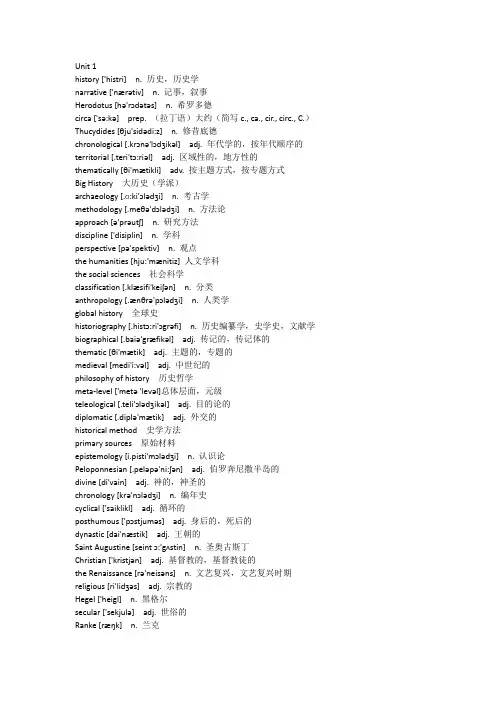
Unit 1history ['histri] n. 历史,历史学narrative ['nærətiv] n. 记事,叙事Herodotus [hə'rɔdətəs] n. 希罗多德circa ['sə:kə] prep. (拉丁语)大约(简写c., ca., cir., circ., C.)Thucydides [θju'sidədi:z] n. 修昔底德chronological [.krɔnə'lɔdʒikəl] adj. 年代学的,按年代顺序的territorial [.teri'tɔ:riəl] adj. 区域性的,地方性的thematically [θi'mætikli] adv. 按主题方式,按专题方式Big History 大历史(学派)archaeology [.ɑ:ki'ɔlədʒi] n. 考古学methodology [.meθə'dɔlədʒi] n. 方法论approach [ə'prəutʃ] n. 研究方法discipline ['disiplin] n. 学科perspective [pə'spektiv] n. 观点the humanities [hju:'mænitiz] 人文学科the social sciences 社会科学classification [.klæsifi'keiʃən] n. 分类anthropology [.ænθrə'pɔlədʒi] n. 人类学global history 全球史historiography [.histɔ:ri'ɔgrəfi] n. 历史编纂学,史学史,文献学biographical [.baiə'græfikəl] adj. 传记的,传记体的thematic [θi'mætik] adj. 主题的,专题的medieval [medi'i:vəl] adj. 中世纪的philosophy of history 历史哲学meta-level ['metə 'levəl]总体层面,元级teleological [.teli'ɔlədʒikəl] adj. 目的论的diplomatic [.diplə'mætik] adj. 外交的historical method 史学方法primary sources 原始材料epistemology [i.pisti'mɔlədʒi] n. 认识论Peloponnesian [.peləpə'ni:ʃən] adj. 伯罗奔尼撒半岛的divine [di'vain] adj. 神的,神圣的chronology [krə'nɔlədʒi] n. 编年史cyclical ['saiklikl] adj. 循环的posthumous ['pɔstjuməs] adj. 身后的,死后的dynastic [dai'næstik] adj. 王朝的Saint Augustine [seint ɔ:'gʌstin] n. 圣奥古斯丁Christian ['kristjən] adj. 基督教的,基督教徒的the Renaissance [rə'neisəns] n. 文艺复兴,文艺复兴时期religious [ri'lidʒəs] adj. 宗教的Hegel ['heigl] n. 黑格尔secular ['sekjulə] adj. 世俗的Ranke [ræŋk] n. 兰克epic ['epik] adj. 史诗的,叙事的;史诗,叙事诗nationalistic [.næʃənəl'istik] adj. 民族主义的Fernand Braudel [fer'nan brɔ'del] 费尔南•布罗代尔Le Roy Ladurie [lə rwa ladju'ri:] 拉鲁瓦•拉杜里Marc Bloch [mark blɔk] 马克•布洛克Lucien Febvre [lysjæn fevr] 吕西安•费弗尔multi-disciplinary [.mʌlti'disiplinəri] adj. 多学科的the Annales ['ænəlz] School 年鉴学派quantitative history 数量史学raw data 原始数据ethnic ['eθnik] adj. 族群的,族裔的racial ['reiʃəl] adj. 种族的genre ['ʒɑ:nrə] n. 类型,流派,风格history of everyday life 日常生活史Marxist ['mɑ:ksist] adj., n. 马克思主义(者)的;马克思主义者Eric Hobsbawm ['erik 'hɔbsbɔm] 埃里克•霍布斯鲍姆Georges Lefebvre [ʒɔrʒ lə'fevr] 乔治•勒费弗尔François Furet [fran'swa fy're] 弗朗索瓦•弗雷Roland Mousnier [rɔ'lan mu:'njei] 罗兰•穆尼埃anti-Marxist adj. 反马克思主义的feminist ['feminist] adj. 女性主义的,女权主义的;女权主义者postmodernist [.pəust'mɔdərnist] n., adj. 后现代主义者;后现代主义(者)的Richard Evans ['ritʃəd 'evənz] 理查德•埃文斯Keith Windschuttle [keiθ 'winʃʌtl] 凯斯•温修德historical periodization [piəriədai'zeiʃən] 历史分期classificatory [.klæsifi'keitəri] adj. 类别的,分类上的retrospective [.retrəu'spektiv] adj. 事后回想的,回顾的the Gilded Age 镀金时代the Dark Age(s) 黑暗时代the First World War 第一次世界大战decimal ['desiməl] adj. 十进法的,以十为基础的talismanic [.tæliz'mænik] adj. 护符(般)的,有护符般效力的the Victorian [vik'tɔ:riən] Era 维多利亚时代the Napoleonic [nə.pəuli'ɔnik] Era 拿破仑时代the Meiji ['mei'dʒi:] Era 明治时代the Merovingian [.mærə'vindʒiən] Period 墨洛温王朝时期Romantic [rə'mæntik] period 浪漫主义时期the sexual ['seksjuəl] revolution 性革命conservative [kən'sə:vətiv] adj. 保守的Roman Catholic ['kæθəlik] culture 罗马天主教文化Franco ['frɔŋkəu] n. 弗朗哥Unit 2primitive culture 原始文化Paul Tournal [pɔl turnal] 保罗·杜纳尔anté-historique ['a:ŋtei 'istɔrik] n.(法语)史前的prehistoric ['pri:his'tɔrik] n. 史前的Daniel Wilson ['dænjəl 'wilsn] 丹尼尔·威尔逊prehistorian [pri:hi'stɔ:riən] n. 从事史前史研究的专家,史前史学家the Stone Age 石器时代the Bronze Age 青铜器时代the Iron Age 铁器时代excavation [.ekskə'veiʃən] n. 发掘geologic [dʒiə'lɔdʒik] adj. 地质学的geographic [dʒiə'græfik] adj. 地理学的literate ['litərit] adj. 识字的,有文化的geneticist [dʒi'netisist] n. 遗传学家linguist ['liŋgwist] n. 语言学家paleontology [.pæliɔn'tɔlədʒi] n. 古生物学biology [bai'ɔlədʒi] n. 生物学geology [dʒi'ɔlədʒi] n. 地质学archaeoastronomy [.ɑ:kiəuəs'trɔnəmi] n. 考古天文学linguistics [liŋ'gwistiks] n. 语言学molecular [mə'lekjulə] adj. 分子的genetics [dʒi'netiks] n. 遗传学archaeological [.a:kiə'lɔdʒikəl] adj. 考古的,考古学上的artifact ['ɑ:tifækt] n. 人工制品anonymous [ə'nɔniməs] adj. 无名无姓的,匿名的Neanderthal [ni'ændətɑ:l] n. 尼安德特人academic [.ækə'demik] adj. 学术上的,从事学术研究的New Guinea [nju: 'gini] n. 新几内亚Paleolithic [.pæliəu'liθik] n. 旧石器时代;adj. 旧石器时代的the Lower Paleolithic 旧石器时代早期Homo sapiens ['həuməu 'seipienz] n. 智人(现代人的学名)Homo habilis ['həuməu 'hæbilis] n. 能人species ['spi:ʃi:z] n. 种类,物种usher ['ʌʃə] vi. 引入,引导anatomic [.ænə'tɔmik] adj. 解剖学上的burial ['beriəl] n. 埋葬,葬礼,坟墓sophisticated [sə'fisti.keitid] adj. 复杂的,精密的,老练的highlight ['hailait] n. 精彩部分,闪光点the Middle Paleolithic 旧石器时代中期the Cro-Magnon ['krəʊ'mænjɔŋ] n. 克罗马尼翁人nomadic [nəu'mædik] adj. 游牧的,游牧民族的,流浪的hunter-gatherer n. 捕猎采集者egalitarian [i.gæli'tɛəriən] adj. 平等主义的sedentary ['sedən.təri] adj. 定居的,固定不动的chiefdom ['tʃi:fdəm] n. 首领的地位,首领的权威stratification [.strætifi'keiʃən] n. 分层indigenous [in'didʒinəs] adj. 土著的,土生土长的,本地的the Upper Paleolithic 旧石器时代晚期Mesolithic [.mesə'liθik] n. 中石器时代;adj. 中石器时代的the Middle Stone Age 中石器时代Neolithic [.ni:əu'liθik] n. 新石器时代;adj. 新石器时代的Pleistocene ['plaistəusi:n] n. 更新世;adj. 更新世的millennia [mi'leniə] (millenniums) n. 数千年marshland ['mɑ:ʃlænd] n. 沼泽地midden ['midn] n. 贝冢deforestation [.di:fɔris'teiʃən] n. 森林开发,滥发森林composite ['kɔmpəzit] adj. 合成的,复合的flint [flint] n. 极硬的东西,打火石microlith ['maikrəliθ] n. 细石器microburin [.maikrə'bjuərin] n. 小雕刻刀tackle ['tækəl] n. 用具,滑车adze, adz [ædz] n. 锛子canoe [kə'nu:] n. 独木舟bow [bəu] n. 弓the New Stone Age 新石器时代domestication [də.mesti'keiʃən] n. 驯养,驯化warfare ['wɔ:fɛə] n. 战争,战事Stonehenge ['stəun'hendʒ] n. 巨石阵millennium [mi'leniəm] n. 一千年Sumerians [su:'miriəns] n. 苏美尔人Peru [pə'ru:] n. 秘鲁Mesoamerica [.mezəuə'merikə] n. 中美洲the Fertile Crescent ['kresənt] n. 新月沃地(西亚伊拉克两河流域连接叙利亚一带地中海东岸的一片弧形地区,为上古文明发源地之一)irrigation [.iri'geiʃən] n. 灌溉the Metal Age 金属时代Chalcolithic [.kælkə'liθik] n. 铜石并用时代;adj. 铜石并用时代的the Old World 旧大陆,东半球(尤指欧洲)metallurgy [me'tælədʒi] n. 冶金术,冶金学metalworking ['metəl.wə:kiŋ] n. 金属加工tin [tin] n. 锡outcropping ['autkrɔpiŋ] n. 露出,露出地表arsenic ['ɑ:sənik] n. 砷,砒霜ferrous ['ferəs] adj. 含铁的cradle ['kreidəl] n. 摇篮,发源地valley ['væli] n. 流域Euphrates [ju:'freiti:z] n. 幼发拉底河Tigris ['taigris] n. 底格里斯河Mesopotamia [.mesəpə'teimiə] n. 两河流域Nile [nail] n. 尼罗河Indus ['indəs] n. 印度河subcontinent [sʌb'kɔntinənt] n. 次大陆adjacent [ə'dʒeisənt] adj. 临近的implement ['implimənt] n. 工具,器具ornament ['ɔ:nəmənt] n. 装饰物,装饰。
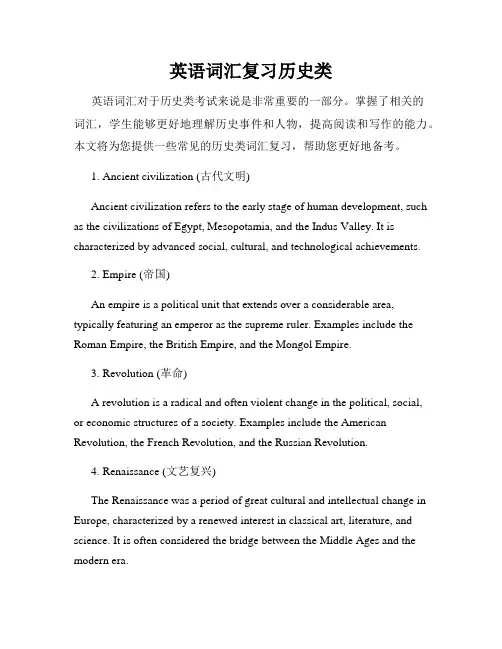
英语词汇复习历史类英语词汇对于历史类考试来说是非常重要的一部分。
掌握了相关的词汇,学生能够更好地理解历史事件和人物,提高阅读和写作的能力。
本文将为您提供一些常见的历史类词汇复习,帮助您更好地备考。
1. Ancient civilization (古代文明)Ancient civilization refers to the early stage of human development, such as the civilizations of Egypt, Mesopotamia, and the Indus Valley. It is characterized by advanced social, cultural, and technological achievements.2. Empire (帝国)An empire is a political unit that extends over a considerable area, typically featuring an emperor as the supreme ruler. Examples include the Roman Empire, the British Empire, and the Mongol Empire.3. Revolution (革命)A revolution is a radical and often violent change in the political, social,or economic structures of a society. Examples include the American Revolution, the French Revolution, and the Russian Revolution.4. Renaissance (文艺复兴)The Renaissance was a period of great cultural and intellectual change in Europe, characterized by a renewed interest in classical art, literature, and science. It is often considered the bridge between the Middle Ages and the modern era.5. Industrialization (工业化)Industrialization refers to the process of transforming an agrarian, rural society into one based on industry and manufacturing. It is often associated with the rise of factories, urbanization, and technological advancements.6. Colonialism (殖民主义)Colonialism is the policy or practice of claiming and dominating foreign lands and peoples. It was a significant feature of European expansion during the 15th to 20th centuries. Examples include the British Empire and the Scramble for Africa.7. Nationalism (民族主义)Nationalism is an ideology that emphasizes the interests, culture, and self-determination of a particular nation or group of people. It played a significant role in the breakup of empires and the formation of new nations in the 19th and 20th centuries.8. World War (世界大战)A world war is a conflict involving multiple nations on a global scale. The two most famous examples are World War I and World War II, which had a profound impact on the political and social landscape of the 20th century.9. Cold War (冷战)The Cold War was a state of geopolitical tension between the United States and the Soviet Union and their respective allies. It lasted from the late1940s to the early 1990s and was characterized by political, economic, and military competition.10. Civil rights movement (民权运动)The civil rights movement was a social and political movement advocating for equal rights and treatment for racial minorities, primarily in the United States. It peaked in the 1950s and 1960s and led to significant legislative and social changes.以上是一些常见的历史类英语词汇,通过对这些词汇的复习,您将能够更好地理解历史事件和人物,并在考试中取得更好的成绩。
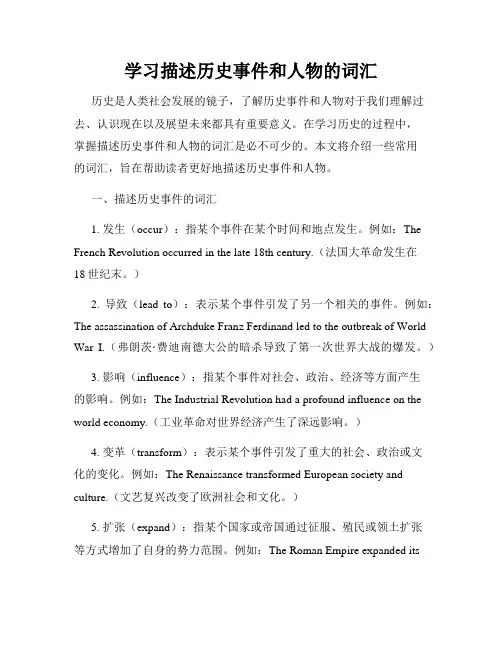
学习描述历史事件和人物的词汇历史是人类社会发展的镜子,了解历史事件和人物对于我们理解过去、认识现在以及展望未来都具有重要意义。
在学习历史的过程中,掌握描述历史事件和人物的词汇是必不可少的。
本文将介绍一些常用的词汇,旨在帮助读者更好地描述历史事件和人物。
一、描述历史事件的词汇1. 发生(occur):指某个事件在某个时间和地点发生。
例如:The French Revolution occurred in the late 18th century.(法国大革命发生在18世纪末。
)2. 导致(lead to):表示某个事件引发了另一个相关的事件。
例如:The assassination of Archduke Franz Ferdinand led to the outbreak of World War I.(弗朗茨·费迪南德大公的暗杀导致了第一次世界大战的爆发。
)3. 影响(influence):指某个事件对社会、政治、经济等方面产生的影响。
例如:The Industrial Revolution had a profound influence on the world economy.(工业革命对世界经济产生了深远影响。
)4. 变革(transform):表示某个事件引发了重大的社会、政治或文化的变化。
例如:The Renaissance transformed European society and culture.(文艺复兴改变了欧洲社会和文化。
)5. 扩张(expand):指某个国家或帝国通过征服、殖民或领土扩张等方式增加了自身的势力范围。
例如:The Roman Empire expanded itsterritories through military conquests.(罗马帝国通过军事征服扩张了其领土。
)二、描述历史人物的词汇1. 领导者(leader):指在某个时期或事件中起领导作用的人。
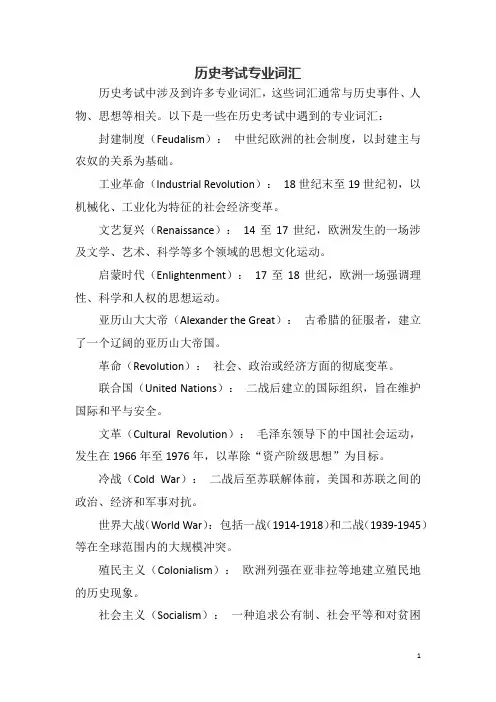
历史考试专业词汇历史考试中涉及到许多专业词汇,这些词汇通常与历史事件、人物、思想等相关。
以下是一些在历史考试中遇到的专业词汇:封建制度(Feudalism):中世纪欧洲的社会制度,以封建主与农奴的关系为基础。
工业革命(Industrial Revolution):18世纪末至19世纪初,以机械化、工业化为特征的社会经济变革。
文艺复兴(Renaissance):14至17世纪,欧洲发生的一场涉及文学、艺术、科学等多个领域的思想文化运动。
启蒙时代(Enlightenment):17至18世纪,欧洲一场强调理性、科学和人权的思想运动。
亚历山大大帝(Alexander the Great):古希腊的征服者,建立了一个辽阔的亚历山大帝国。
革命(Revolution):社会、政治或经济方面的彻底变革。
联合国(United Nations):二战后建立的国际组织,旨在维护国际和平与安全。
文革(Cultural Revolution):毛泽东领导下的中国社会运动,发生在1966年至1976年,以革除“资产阶级思想”为目标。
冷战(Cold War):二战后至苏联解体前,美国和苏联之间的政治、经济和军事对抗。
世界大战(World War):包括一战(1914-1918)和二战(1939-1945)等在全球范围内的大规模冲突。
殖民主义(Colonialism):欧洲列强在亚非拉等地建立殖民地的历史现象。
社会主义(Socialism):一种追求公有制、社会平等和对贫困的关切的政治经济体制。
这只是一个小小的范例,历史考试中的专业词汇会根据考试范围和内容有所不同。
建议参考具体的历史教材和考试大纲,以了解相关的专业词汇。
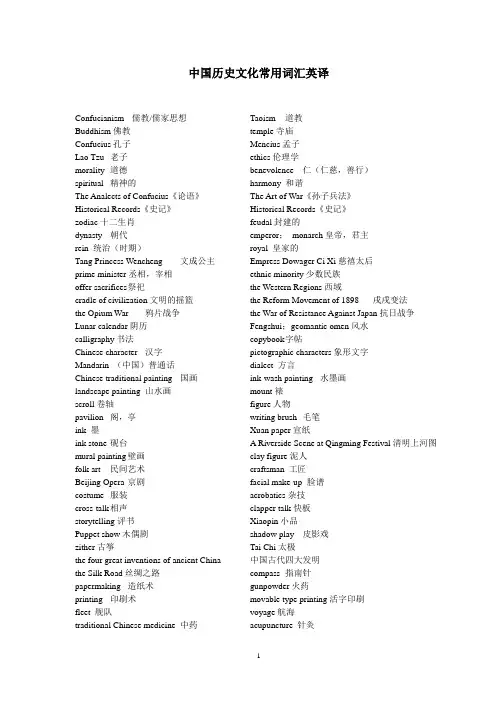
中国历史文化常用词汇英译Confucianism 儒教/儒家思想Taoism 道教Buddhism佛教temple寺庙Confucius孔子Mencius孟子Lao Tzu老子ethics伦理学morality 道德benevolence 仁(仁慈,善行)spiritual 精神的harmony 和谐The Analects of Confucius《论语》The Art of War《孙子兵法》Historical Records《史记》Historical Records《史记》zodiac十二生肖feudal封建的dynasty 朝代emperor;monarch皇帝,君主rein 统治(时期)royal 皇家的Tang Princess Wencheng 文成公主Empress Dowager Ci Xi慈禧太后prime minister丞相,宰相ethnic minority少数民族offer sacrifices 祭祀the Western Regions西域cradle of civilization文明的摇篮the Reform Movement of 1898 戌戌变法the Opium War 鸦片战争the War of Resistance Against Japan抗日战争Lunar calendar阴历Fengshui;geomantic omen风水calligraphy书法copybook 字帖Chinese character 汉字pictographic characters象形文字Mandarin (中国)普通话dialect 方言Chinese traditional painting 国画ink-wash painting 水墨画landscape painting 山水画mount裱scroll卷轴figure人物pavilion 阁,亭writing brush 毛笔ink 墨Xuan paper宣纸ink stone 砚台 A Riverside Scene at Qingming Festival清明上河图mural painting 壁画clay figure泥人folk art 民间艺术craftsman 工匠Beijing Opera 京剧facial make-up 脸谱costume 服装acrobatics杂技cross-talk 相声clapper talk快板storytelling评书Xiaopin小品Puppet show木偶剧shadow play 皮影戏zither古筝Tai Chi太极the four great inventions of ancient China 中国古代四大发明the Silk Road丝绸之路compass 指南针papermaking 造纸术gunpowder火药printing 印刷术movable type printing活字印刷fleet 舰队voyage航海traditional Chinese medicine 中药acupuncture 针灸medical massage推拿herbal medicine草药abacus 算盘bronze ware 青铜器porcelain 瓷器seismograph 地动仪Go/ the game of go 围棋martial arts (Wushu)武术fireworks 烟花firecracker鞭炮statutory holiday 法定假日Spring Festival 春节The Spring Festival Gala on CCTV春节联欢晚会gift of money wrapped in red paper 红包New Year gift-money压岁钱family reunion团圆Lantern Festival元宵节Dragon Boat Festival 端午节sticky rice dumplings粽子Mid-autumn Festival 中秋节moon cake 月饼the Double Seventh Festival 七夕Spring Festival couplets 对联temple fair庙会festival lantern花灯lantern riddle灯谜God of Wealth 财神dumpling 饺子dragon boat race 龙舟赛dragon and lion dance 狮子龙灯舞stilt walking踩高跷dragon boat race赛龙舟kite flying 放风筝Yanggo dance 秧歌舞Chinese cuisine中国菜color色aroma香taste , flavor 味chopsticks 筷子Sichuan cuisine川菜soybean milk 豆浆deep-fried dough sticks油条steamed buns 馒头steamed twisted rolls花卷steamed stuffed buns包子Beijing roast duck北京烤鸭hand-stretched noodles拉面hot pot火锅tofu 豆腐instant noodles 方便面wood-cut block print 木刻版画papercutting, paper-cuts 剪纸Chinese Spring Festival Paintings年画cloisonne 景泰蓝embroidery刺绣Suzhou embroider y苏绣batik 蜡染pattern 图案decorate v. 装饰decoration n. 装饰Chinese tunic suit 中山装cheongsam (qipao ) 旗袍Tang-style costume 唐装feature 特色unique to China 中国特有的characteristic 特点the Imperial Palace故宫the Forbidden City 紫禁城Beijing quadrangles北京四合院hutong胡同the Temple of Heaven 天坛The Summer Palace 颐和园the Great Wall 长城drum tower鼓楼the Terra-cotta Army of the First Emperor of Qin兵马俑the Mausoleum of Emperor Huangdi黄帝陵scenery, landscape 风景place of interests名胜tourist attraction/resort 观光胜地sightsee v. 观光,游览Mount Huangshan 黄山the Jiuzhaigou Valley 九寨沟the Mogao Caves 莫高窟giant panda 大熊猫rare 珍稀的bamboo竹子endangered 濒临灭绝的preserve 保存,保护,保护区。
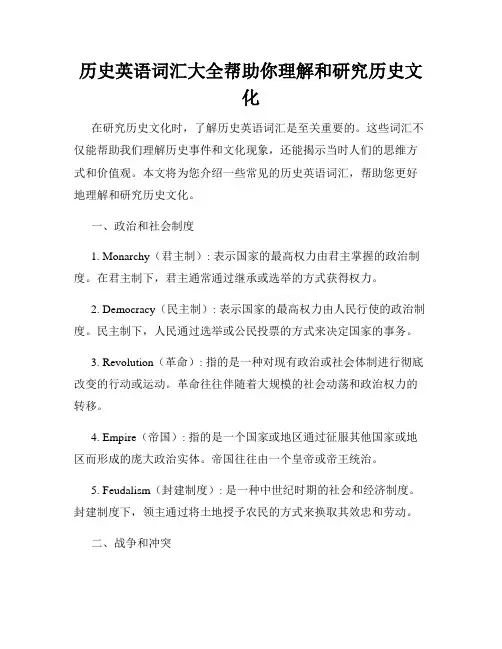
历史英语词汇大全帮助你理解和研究历史文化在研究历史文化时,了解历史英语词汇是至关重要的。
这些词汇不仅能帮助我们理解历史事件和文化现象,还能揭示当时人们的思维方式和价值观。
本文将为您介绍一些常见的历史英语词汇,帮助您更好地理解和研究历史文化。
一、政治和社会制度1. Monarchy(君主制): 表示国家的最高权力由君主掌握的政治制度。
在君主制下,君主通常通过继承或选举的方式获得权力。
2. Democracy(民主制): 表示国家的最高权力由人民行使的政治制度。
民主制下,人民通过选举或公民投票的方式来决定国家的事务。
3. Revolution(革命): 指的是一种对现有政治或社会体制进行彻底改变的行动或运动。
革命往往伴随着大规模的社会动荡和政治权力的转移。
4. Empire(帝国): 指的是一个国家或地区通过征服其他国家或地区而形成的庞大政治实体。
帝国往往由一个皇帝或帝王统治。
5. Feudalism(封建制度): 是一种中世纪时期的社会和经济制度。
封建制度下,领主通过将土地授予农民的方式来换取其效忠和劳动。
二、战争和冲突1. Battle(战役): 指的是两个或多个军队之间的武装冲突。
战役往往是战争中的一个重要组成部分。
2. Treaty(条约): 是两个或多个国家之间达成的正式协议。
条约通常用于结束战争、确立边界或解决争端。
3. Siege(围攻): 是一种军事行动,指的是军队包围并困住敌方城市或堡垒,以迫使其放弃。
4. Alliance(联盟): 表示两个或多个国家或组织之间的正式合作关系。
联盟的目的可以是共同对抗其他威胁或实现共同利益。
5. Rebellion(叛乱): 指的是一群人对现有政权进行反抗或起义的行动。
叛乱往往由于政府压迫、不公正或不满所引起。
三、文化和艺术1. Renaissance(文艺复兴): 是欧洲历史上的一段时期,标志着艺术、文学和科学的繁荣和复兴。
文艺复兴时期对人类知识和文化的重要贡献至今仍受到赞誉。
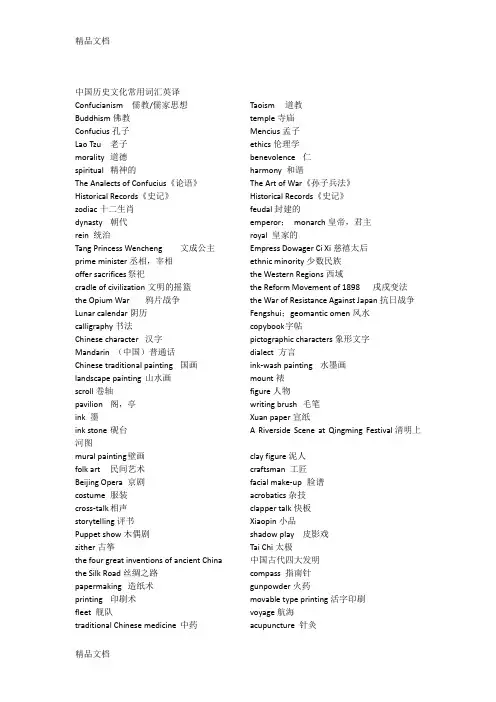
中国历史文化常用词汇英译Confucianism 儒教/儒家思想Taoism 道教Buddhism佛教temple寺庙Confucius孔子Mencius孟子Lao Tzu 老子ethics伦理学morality 道德benevolence 仁spiritual 精神的harmony 和谐The Analects of Confucius《论语》The Art of War《孙子兵法》Historical Records《史记》Historical Records《史记》zodiac十二生肖feudal封建的dynasty 朝代emperor;monarch皇帝,君主rein 统治royal 皇家的Tang Princess Wencheng 文成公主Empress Dowager Ci Xi慈禧太后prime minister丞相,宰相ethnic minority少数民族offer sacrifices 祭祀the Western Regions西域cradle of civilization文明的摇篮the Reform Movement of 1898 戌戌变法the Opium War 鸦片战争the War of Resistance Against Japan抗日战争Lunar calendar阴历Fengshui;geomantic omen风水calligraphy书法copybook 字帖Chinese character 汉字pictographic characters象形文字Mandarin (中国)普通话dialect 方言Chinese traditional painting 国画ink-wash painting 水墨画landscape painting 山水画mount裱scroll卷轴figure人物pavilion 阁,亭writing brush 毛笔ink 墨Xuan paper宣纸ink stone 砚台 A Riverside Scene at Qingming Festival清明上河图mural painting 壁画clay figure泥人folk art 民间艺术craftsman 工匠Beijing Opera 京剧facial make-up 脸谱costume 服装acrobatics杂技cross-talk 相声clapper talk快板storytelling评书Xiaopin小品Puppet show木偶剧shadow play 皮影戏zither古筝Tai Chi太极the four great inventions of ancient China 中国古代四大发明the Silk Road丝绸之路compass 指南针papermaking 造纸术gunpowder火药printing 印刷术movable type printing活字印刷fleet 舰队voyage航海traditional Chinese medicine 中药acupuncture 针灸medical massage推拿herbal medicine草药abacus 算盘bronze ware 青铜器porcelain 瓷器seismograph 地动仪Go 围棋martial arts (Wushu)武术fireworks 烟花firecracker鞭炮statutory holiday 法定假日Spring Festival 春节The Spring Festival Gala on CCTV春节联欢晚会gift of money wrapped in red paper 红包New Year gift-money压岁钱family reunion 团圆Lantern Festival元宵节Dragon Boat Festival 端午节sticky rice dumplings粽子Mid-autumn Festival 中秋节moon cake 月饼the Double Seventh Festival 七夕Spring Festival couplets 对联temple fair庙会festival lantern花灯lantern riddle灯谜God of Wealth 财神dumpling 饺子dragon boat race 龙舟赛dragon and lion dance 狮子龙灯舞stilt walking踩高跷dragon boat race赛龙舟kite flying 放风筝Yangge dance 秧歌舞Chinese cuisine中国菜color色aroma香taste , flavor 味chopsticks 筷子Sichuan cuisine川菜soybean milk 豆浆deep-fried dough sticks油条steamed buns 馒头steamed twisted rolls花卷steamed stuffed buns包子Beijing roast duck北京烤鸭hand-stretched noodles拉面hot pot火锅tofu 豆腐instant noodles 方便面wood-cut block print 木刻版画papercutting, paper-cuts 剪纸Chinese Spring Festival Paintings年画cloisonne 景泰蓝embroidery刺绣Suzhou embroidery苏绣batik 蜡染pattern 图案decorate v. 装饰decoration n. 装饰Chinese tunic suit 中山装cheongsam (qipao ) 旗袍Tang-style costume 唐装feature 特色unique to China 中国特有的characteristic 特点the Imperial Palace故宫the Forbidden City 紫禁城Beijing quadrangles北京四合院hutong胡同the Temple of Heaven 天坛The Summer Palace颐和园the Great Wall 长城drum tower鼓楼the Terra-cotta Army of the First Emperor of Qin兵马俑the Mausoleum of Emperor Huangdi黄帝陵scenery, landscape 风景place of interests名胜tourist attraction/resort 观光胜地sightsee v. 观光,游览Mount Huangshan 黄山the Jiuzhaigou Valley 九寨沟the Mogao Caves 莫高窟giant panda 大熊猫rare 珍稀的bamboo竹子。
历史专业词汇及其解释一、“君主专制(jūn zhǔ zhuān zhì,名词n.)”1. 解释- 指以古代君王为核心的中央集权的政治体制。
君主拥有至高无上的权力,在这种体制下,君主独揽国家大权,决策往往取决于君主个人意志,不受其他机构或阶层的有效制约。
例如中国古代的秦朝,秦始皇建立了高度集权的君主专制制度,他总揽政治、军事、经济等一切大权。
二、“封建制度(fēng jiàn zhì dù,名词n.)”1. 解释- 在不同语境下有不同含义。
在中国古代,封建制是指封邦建国的制度,即天子把土地和人民分封给诸侯,诸侯在自己的封国内享有相对独立的统治权,诸侯又可以把土地和人民再分封给卿大夫等。
在西欧中世纪,封建制度则是以土地分封为基础,形成了领主与附庸之间的权利和义务关系,领主给予附庸土地(采邑),附庸则要为领主服兵役等。
三、“文艺复兴(wén yì fù xīng,名词n.)”1. 解释四、“工业革命(gōng yè gé mìng,名词n.)”1. 解释- 指资本主义工业化的早期历程,也称产业革命。
它是从工场手工业向机器大工业的过渡。
18世纪60年代首先从英国开始,以珍妮纺纱机的发明为开端,随后瓦特改良蒸汽机广泛应用于工业生产,带动了一系列的技术变革。
工业革命使生产力得到极大提高,工厂制度兴起,城市化进程加快,也引起了社会结构和国际关系等多方面的深刻变革,之后传播到其他国家,对世界历史发展产生了深远影响。
五、“启蒙运动(qǐméng yùn dòng,名词n.)”1. 解释- 17 - 18世纪欧洲的一场思想解放运动。
“启蒙”的意思是启迪和开导人们的反封建意识。
启蒙思想家们批判封建专制制度和天主教会,倡导自由、平等、民主等思想观念,如伏尔泰倡导天赋人权,孟德斯鸠提出三权分立学说,卢梭提出社会契约论等。
历史英语词汇大全解读历史事件的关键词历史事件的理解和解释需要掌握丰富的英语词汇表。
本文将为您呈现历史英语词汇大全,通过解读这些关键词,帮助您更好地理解历史事件。
1. Dynasty(王朝)A series of rulers or leaders from the same family who rule a country for a long period of time. The word "dynasty" is often used to describe the ruling families in ancient China, such as the Han Dynasty or the Tang Dynasty.2. Revolution(革命)A sudden and dramatic change in political power or social structure. The word "revolution" is often associated with events such as the French Revolution or the Industrial Revolution.3. Empire(帝国)A group of countries or regions under the control of a powerful nation. The word "empire" is commonly used to describe historical empires such as the Roman Empire or the British Empire.4. Colonization(殖民)The process of establishing settlements or colonies in a new territory, often by a more powerful country. The word "colonization" is closely related to historical events like the colonization of the Americas by European powers.5. Independence(独立)The state of being free from the control or influence of others. The word "independence" is often used to describe significant events like the American Declaration of Independence or the Indian Independence Movement.6. Treaty(条约)A formal agreement between two or more countries or groups. The word "treaty" is frequently used to refer to historical agreements like the Treaty of Versailles or the Treaty of Tordesillas.7. Exploration(探险)The act of traveling to new or unfamiliar places in order to discover or learn about them. The word "exploration" is commonly associated with historical figures like Christopher Columbus or Zheng He.8. Dictatorship(独裁)A form of government where a single ruler or a small group possesses absolute power and authority. The word "dictatorship" is often used to describe regimes such as that of Adolf Hitler or Joseph Stalin.9. Industrialization(工业化)The process of developing industries and transforming an agrarian society into an industrial one. The word "industrialization" is closely linked to events like the Industrial Revolution or the Meiji Restoration in Japan.10. Renaissance(文艺复兴)A period of renewed interest and innovation in the arts, literature, and sciences. The word "renaissance" is commonly associated with the European Renaissance, a time marked by significant cultural and intellectual advancements.11. Rebellion(叛乱)An act of defiance or resistance against an established authority or government. The word "rebellion" is often used to describe historical events like the French Revolution or the American Civil War.12. Cold War(冷战)A state of political tension and military rivalry between the United States and the Soviet Union after World War II. The term "Cold War" is frequently used to describe the geopolitical climate from the late 1940s to the early 1990s.13. Abolition(废除)The act of officially ending or eliminating a system or practice, especially slavery. The word "abolition" is commonly associated with historical movements such as the abolition of slavery in the United States or the British abolitionist movement.14. Nationalism(民族主义)A strong feeling of pride, loyalty, and devotion to one's own nation or ethnic group. The word "nationalism" is often linked to historical events like the unification of Germany or struggles for independence in various countries.15. Holocaust(大屠杀)The systematic extermination of approximately six million Jews by the Nazis during World War II. The term "holocaust" is used specifically to refer to this tragic event in history.通过解读上述关键词,我们可以更加全面地了解历史事件和相关的历史背景。
形容中国历史的词语有哪些中国历史源远流长,是世界上历史最为悠久的国家之一。
历经数千年的沧桑与变迁,中国历史上涌现出了许多富有内涵的词汇,下面就让我们一起来探讨一下。
1. 五千年文明“五千年文明”是形容中国历史的经典词语。
它表达了中国历史源远流长、博大精深、充满着独特与神秘的文化氛围。
在长达五千年的历史长河中,中华民族创造了煌煌壮丽的古代文明,展现了中华文化的千姿百态。
2. 文化古国“文化古国”是对中国历史的另一种形容。
它主要强调中国历史悠久的文化底蕴和丰富多彩的文化成就。
中国自古以来就是一个以文化为主导的国家,几千年来,在诗歌、科学、哲学、绘画、雕刻等方面都有着卓越的成就,在世界文化史上占有重要的地位。
3. 统一多元“统一多元”是形容中华文明的一个重要方面。
中华文明强调统一性,但同时又兼容并包,尊重多元性。
中国历史上许多朝代都非常重视统一和稳定,但是在各个地区都留下了不同的文化特色,形成了众多具有地方特色的文化。
4. 崇尚和平“崇尚和平”是中华文明的重要特征之一,也是中国历史上的一个标志。
中国历史上有许多和平的时期,这些时期经常是文化繁荣、经济发展的时期。
中华文明以和平为目标,强调人与人之间的和谐相处,极少有扩张主义的色彩。
5. 求索不止“求索不止”是表达中华文明探索精神的词汇。
中国历史上有很多思想家、哲学家、科学家、文艺家,他们通过对人性、世界、天地的思考,不断求索、探索。
这种求索精神贯穿了整个中国历史,是中华文明的重要宝藏。
总之,中国历史源远流长、博大精深,涵盖了众多的方面,每一方面都有着独特的表述和诠释。
通过对这些词语的了解,能够更好地认识和理解中国历史,深入领略中华文明的博大精深。
中国历史词汇汉英对照表一、古代朝代及其对应英文译名:1. 夏朝(Xia Dynasty)夏朝是中国历史上的第一个朝代,大约出现在公元前21世纪至前16世纪之间。
2. 商朝(Shang Dynasty)商朝是中国历史上的第二个朝代,大约出现在公元前16世纪至前11世纪之间。
3. 周朝(Zhou Dynasty)周朝是中国历史上的第三个朝代,分为西周和东周两个时期,大约出现在公元前11世纪至公元前256年之间。
4. 秦朝(Qin Dynasty)秦朝是中国历史上的第一个统一中央集权国家,出现在公元前221年至公元前206年之间。
5. 汉朝(Han Dynasty)汉朝是中国历史上的第一个永久性统一国家,分为西汉和东汉两个时期,大约出现在公元前206年至公元220年之间。
6. 魏晋南北朝(Wei, Jin, Southern and Northern Dynasties)魏晋南北朝是中国历史上的时期,从西晋灭亡(公元280年)到隋朝建立(公元581年)之间,持续了近300年。
7. 隋朝(Sui Dynasty)隋朝是中国历史上的第二个统一中央集权国家,出现在公元581年至公元618年之间。
8. 唐朝(T ang Dynasty)唐朝是中国历史上的一个辉煌时期,被视为中国历史上最强盛的朝代之一,大约出现在公元618年至公元907年之间。
9. 宋朝(Song Dynasty)宋朝是中国历史上的一个重要朝代,分为北宋和南宋两个时期,大约出现在公元960年至公元1279年之间。
10. 元朝(Yuan Dynasty)元朝是中国历史上的第一个由蒙古人建立的朝代,大约出现在公元1271年至公元1368年之间。
11. 明朝(Ming Dynasty)明朝是中国历史上的一个重要朝代,大约出现在公元1368年至公元1644年之间。
12. 清朝(Qing Dynasty)清朝是中国历史上的最后一个封建王朝,大约出现在公元1644年至公元1912年之间。
历史学英语词汇大全了解历史学理论与历史事件的专业术语历史学英语词汇大全:了解历史学理论与历史事件的专业术语历史学是研究过去的人类社会发展过程的学科,它深入研究历史事件、历史理论等内容。
随着全球化的进程,历史学的研究范围也不断扩大,历史学英语词汇作为学科专业术语的一部分,对于学习和理解历史学理论与历史事件起着重要的作用。
下文将为您介绍一些常用的历史学英语词汇,帮助您更好地了解历史学领域。
1. Historiography(历史学方法论):研究历史学研究方法的学科。
历史学家通过采用不同的方法和视角,对历史事件进行研究和解释。
2. Primary sources(一手资料):直接反映历史事件发生情况的原始历史资料,如古代文献、手稿、照片、报纸等。
3. Secondary sources(二手资料):在一手资料的基础上加工整理而形成的历史学研究成果,如历史学著作、论文和综述等。
4. Archives(档案):保存历史遗留下来的一手资料的机构,如国家档案馆、图书馆、博物馆等。
5. Historicism(历史唯物主义):一种历史学理论,认为社会、经济和政治环境是影响历史事件发生和发展的主要因素。
6. Intertextuality(互文性):历史事件之间的相互关联和互相影响的现象,在历史研究中起着重要作用。
7. Oral history(口述历史):通过口头传承的方式记录和研究历史事件,尤其是平民百姓的视角和经历。
8. Historically significant(具有历史意义的):指对于历史发展有重要影响或重大意义的事件、人物或现象。
9. Historical context(历史背景):指历史事件发生时的社会、政治、经济、文化等方面的条件和环境。
10. Historiographical debate(历史学术争论):历史学领域不同学者对于某一历史问题或事件的观点和解释存在分歧的辩论。
11. Primary research(一手研究):历史学研究者自行收集和分析一手资料来探索历史问题。
Taoism 道教 temple 寺庙Mencius 孟子 ethics 伦理学 benevolence 仁 harmony 和谐The Art of War 《孙子兵法》Historical Records 《史记》 feudal 封建的 emperor ; monarch 皇帝,君主 royal 皇家的Empress Dowager Ci Xi 慈禧太后 ethnic minority 少数民族the Western Regio ns 西域the Reform Movement of 1898 戌戌变法 the War of Resista nee Aga inst Japan% 日战争 Fengshui ; geomantic omen 风水 copybook 字帖pictographic characters 象形文字 dialect 方言 ink-wash painting 水墨画 mount 裱 figure 人物 writing brush 毛笔 Xuan paper 宣纸A Riverside Scene at Qi ngmi ng Festiva 清明上河clay figure 泥人 craftsman 工匠 facial make-up 脸谱 acrobatics 杂技 clapper talk 快板 Xiaopin 小品 shadow play 皮影戏 Tai Chi 太极 中国古代四大发明 compass 指南针 gunpowder 火药 movable type printing 活字印刷 voyage 航海中国历史文化常用词汇英译 Confucianism 儒教 / 儒家思想 Buddhism 佛教 Confucius 孔子 Lao Tzu 老子 morality 道德 spiritual 精神的The Analects of Confucius 《论语》 Historical Records 《史记》 zodiac 十二生肖 dynasty 朝代 rein 统治 Tang Princess Wencheng 文成公主 prime minister 丞相,宰相 offer sacrifices 祭祀cradle of civilization 文明的摇篮 the Opium War 鸦片战争Lunar cale ndar 阴历 calligraphy 书法 Chinese character 汉字 Mandarin (中国)普通话 Chinese traditional painting 国画 landscape painting 山水画 scroll 卷轴 pavilion 阁,亭 ink 墨 ink stone 砚台 图mural painting 壁画 folk art 民间艺术 Beijing Opera 京剧 costume 服装 cross-talk 相声 storytelling 评书Puppet show 木偶剧 zither 古筝 the four great inventions of ancient China the Silk Road 丝绸之路 papermaking 造纸术 printing 印刷术 fleet 舰队traditional Chinese medicine 中药medical massage推拿abacus 算盘porcelain 瓷器Go 围棋fireworks 烟花Spring Festival couplets 对联festival lantern 花灯God of Wealth 财神dragon boat race 龙舟赛stilt walking 踩高跷kite flying 放风筝Chin ese cuis ine 中国菜aroma 香chopsticks 筷子soybean milk 豆浆steamed buns 馒头steamed stuffed buns包子hand —stretched no odles 拉面tofu豆腐wood-cut block print 木刻版画Chinese Spring Festival Pain ti ngs年画embroidery 刺绣batik 蜡染decorate v. 装饰Chinese tunic suit 中山装Tang-stylecostume 唐装unique to China 中国特有的the Imperial Palace 故宫Beiji ng quadra ngles寸匕京四合院theTemple of Heaven 天坛the Great Wall 长城the Terra-cotta Army of the First Emperor ofQin 黄帝陵sce nery, la ndscape风景tourist attraction/resort 观光胜地Mount Huangshan 黄山the Mogao Caves 莫高窟acupuncture 针灸herbal medici ne 草药bronze ware 青铜器seismograph 地动仪martial arts (Wushu)武术firecracker 鞭炮Spring Festival 春节gift of money wrapped in red paper 红包family reunion 团圆Dragon Boat Festival 端午节Mid-autumn Festival 中秋节the Double Seventh Festival 七夕temple fair 庙会兵马俑the Mausoleum of Emperor Huangdi place of in terests 名胜sightsee v. 观光,游览the Jiuzhaigou Valley 九寨沟giant panda 大熊猫statutory holiday 法定假日The Spring Festival Gala on CCTV 春节联欢晚会New Year gift—money 压岁钱Lantern Festival 元宵节sticky rice dumplings 粽子moon cake 月饼lantern riddle 灯谜dumpling 饺子dragon and lion dance 狮子龙灯舞drago n boat race 赛龙舟Yanggedance 秧歌舞color 色taste , flavor 味Sichua n cuis ine川菜deep—fried dough sticks 油条steamed twisted rolls 花卷Beijing roastduck 匕京烤鸭hot pot 火锅instantnoodles 方便面papercutting, paper-cuts剪纸cloisonne 景泰蓝Suzhouembroidery 苏绣pattern 图案decorationn. 装饰cheongsam (qipao ) 旗袍feature特色characteristic 特点the ForbiddenCity 紫禁城hutong 胡同The Summer Palace 颐和园drum tower鼓楼bamboo 竹子rare 珍稀的。
关于历史的常用词汇据360教育集团介绍:
Indian
印第安人
Giotto
乔托
Buonarroti Michelangelo
米开朗琪罗
Niccolò Machiavelli
马基雅维利
Miguel de Cervantes
塞万提斯
Medieval Period
中世纪
Commercial Revolution
商业革命
Colonialism
殖民主义
slave trade
奴隶贸易
Renaissance
文艺复兴
Humanism
人文主义
Dante
但丁
The Reformation
宗教改革
Calvinists
加尔文派
enclosure movement 圈地运动
House of Stuart
都铎王朝
House of Stuart
斯图亚特王朝
the Anglican Church 英国国教
Puritan
清教徒
Oliver Cromwell
克伦威尔
Lord Protector
护国公
Whig
辉格党
Tory
托利党
Glorious Revolution
光荣革命
Bill of Rights
《权利法案》
Constitutional Monarchy
君主立宪制
House of Bourbon
波旁王朝
House of Habsburg
哈布斯堡王朝
Mercantilism
重商主义
Peter the Great
彼得大帝
The Palace of Versailles 凡尔赛宫
enlightened despotism
开明专制
British East India Company 英国东印度公司
Navigation Acts
《航海条例》
Seven Year’s Wa
r七年战争
Enlightenment
启蒙战争
Encyclopedists
百科全书
the Third Estate
第三等级
Louis XⅥ
路易十六
The Estate-General
三级会议
National assembl
国民议会
Constituent Assembly
制宪议会
the Bastille
巴士监狱
French Revolution
法国大革命
Declaration of the Rights of Man and of the Citizen 《人权宣言》
the Jacobins
雅各宾派
Thermidorian Reaction
热月政变
Directory Government
督政府
Coup d’Etat of Brumaire
雾月政变
the First French Empire
法兰西第一帝国
the Consulate
执政府
the Code Napoleon
《拿破仑法典》
Battle of Waterloo
滑铁卢战役
Common Sense
《常识》
The Continental Congress
大陆会议
Declaration of Independence 《独立宣言》
Shogunate
幕府
samurai
武士
Sedusion Orders
锁国令
the Mughal Empire
莫卧儿帝国
Industrial Revolution 工业革命
flying-shuttle
飞梭
spinning-jenny
珍妮纺纱机
spinning-mule
骡机
water-frame
水力织布机
The Age of Steam
蒸汽时代
The Wealth of Nations 《国富论》
the Congress of Vienna 维也纳会议
Vienna System
维也纳体系
Holly Alliance
神圣同盟
Quadruple Alliance
四国同盟(1813)
Luddite movement
卢德运动
The Communist Manifesto
共产党宣言
Communist League
共产主义者同盟
Scientific Socialism
科学社会主义
Marxism
马克思主义
International Working-men’s Association 国际工人协会
First International
第一国际
Commune of Paris
巴黎公社
Westward Movement
西进运动
Free State
自由州
Slave State
蓄奴州
Homestead Act
宅地法
Emancipation Proclamation 解放黑人奴隶宣言
Civil War (U.S.)
美国内战
Iron and Blood
铁血政策
Meiji Restoration
明治维新
Crimean War
克里米亚战争
the Ottoman Empire
奥斯曼帝国
Bābism
巴布教
Ernst Werner von Siemens 西门子
The Treaty of Kanghua 《江华条约》
The Treaty of Portsmouth 《朴茨茅斯和约》
Suez Canal
苏伊士运河
Second International
第二国际
Vladimir Ilich Lenin
列宁
Austria-Hungary
奥匈帝国
the Triple Alliance
三国同盟
the Triple Entente
三国协约
Archduke Ferdinand
斐迪南大公。